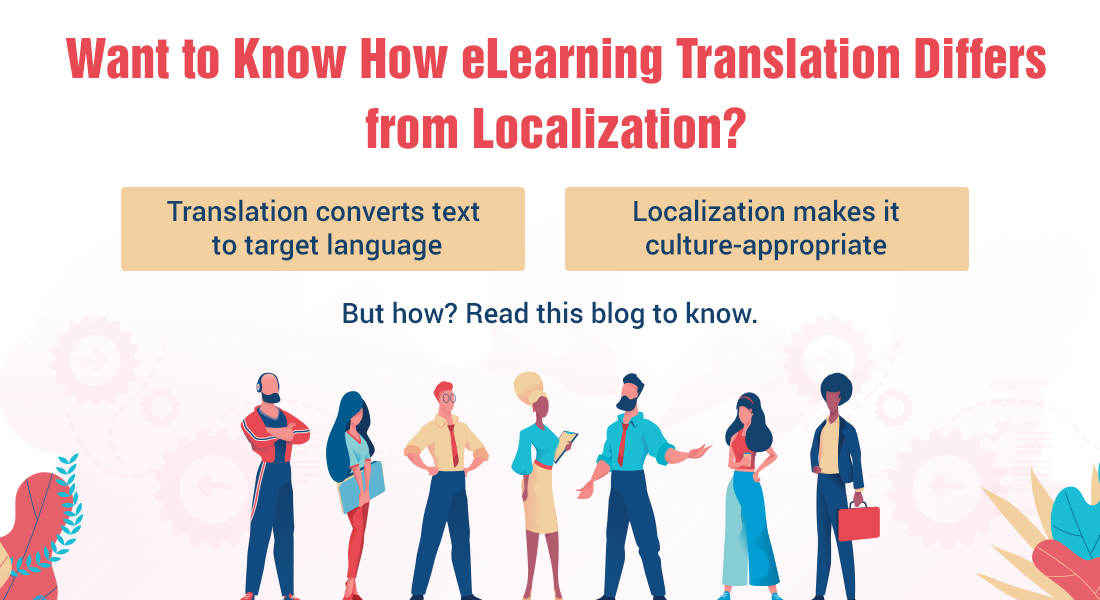Top 4 eLearning Translation Techniques to Reduce Distant Learners’ Disengagement

Growing organizations need a constantly expanding personnel base, and that presents the difficulty of training a globally widespread workforce. Any plans you may have had for setting up classroom training with your remote employees have been put on hold (at least temporarily) due to the current COVID-19 problem. Therefore, you must digitally train your global and remote personnel. Consequently, the issue of “How can I stop global learners from feeling disconnected?” arises. The response? The answer in this case has proven to be eLearning translation.
What Exactly is eLearning Translation?
eLearning translation is the process of translating digital training materials including text, graphics, video clips, and evaluations from one language to many others. With the use of eLearning translation technologies, L&D professionals may modify their training materials to match the local languages of their trainees. This shortens the training time and improves participation and engagement.
Wondering How eLearning Translations Reduce Distant Learners Disengagement?
Here are a Few Ways, it Can Help You:
- Increases Learners’ Feelings of Ease
- Upholds Consistency in Training
- Considers the Training and Understanding of Learners
- Offers Learners Relatable and Contextual Skill Sets
The Importance of Investing in eLearning Translations
If your organization is growing globally, it is crucial to convert your eLearning courses into numerous different languages.
How, you might ask?
Every business considers its personnel to be its most important asset. Do you not believe if learners have had accessibility to the eLearning courses in their primary language, then efficiency would improve? You must give them access to eLearning tools that will enable workers to improve their existing abilities and practice and learn if you want to maintain the foundation robust. Your eLearning courses should be translated into languages which your team members favour for all this to be possible.
Even while the advantages of eLearning translation primarily relate to the variety of economic options and worldwide reach it offers enterprises, we frequently exhibit a tendency to ignore the viewpoint of the learners. Now let us change the scenario and examine how eLearning translation aids international learners in overcoming disconnect caused by language hurdles during remote training.
Top 4 eLearning Translation Techniques to Reduce Distant Learners Disengagement
1. Increases Learners’ Feelings of Ease
To prevent learners from feeling disconnected while completing the course, the training materials should be made accessible in their local languages. This is since they feel more ease speaking their own native tongue and do not have to battle with the complex subtleties of the English language or other foreign language in which the course was originally created.
Even though translation is essential for worldwide remote training, there are several challenges in the process that rely on the linguistic elements of the language specification. As a result, I advise you to adhere to the following recommended practices in mind when translating:
- Avoid utilizing phrases and idioms from the source language – Make certain that source material does not include an excessive number of idioms, phrases, or idiomatic expressions from the original language. It may be challenging for learners to properly comprehend idioms and phrases if there is no relevant equivalent in the target language.
- Attempt to stay away from utilizing instances and tales from daily life – The circumstances of colloquial tales and instances often include societal and cultural resonances that might be well received by learners and, in certain situations, may even be inadvertently hurtful. The isolation of learners grows as a result.
- Follow brief learning material – When translating, the syntax and vocabulary of the target language change the complexity and impact of the sentences. Redundancies may also add to the load for both the translators and the intended audience. Make sure the slides have enough white space to allow the growing text size which may be tweaked.
- Avoid using text in photos – since it is difficult to translate and may slow down translation. Additionally, putting two distinct languages on a learning slide is a huge visual blunder. Avoid using text in picture format.
Regardless of scale, discover how to easily translate your online courses!
2. Upholds Consistency in Training
You cannot exercise complete control over the timing and quality of the training that learners will get when you are preparing a diverse workplace. Technical errors are quite likely to be transmitted. Cross-country training is kept uniform by using a master course that is created in clear terms, without redundancies, has accurate material, and includes a neutral visual design.
Do you wonder if that fixes disengagement?
If your Portuguese, Japanese, and Mexican co-workers were studying the same thing in their respective languages, you probably wouldn’t feel left out. This eventually results in fewer disconnects and better relationships among your global workforces. By developing material with translation in consideration, you will prepare yourselves for quality when it comes to effectively communicating your message and brand values. It also enables businesses to save a lot of money via the translation process instead of starting a course from scratch again.
3. Considers the Training and Understanding of Learners
The translation of employee training sessions enhances retention of knowledge and expedites problem-solving, and improves their ability to assist customers, and contributes to the company’s brand image efforts. This lowers the volume of grievances and inquiries to customer care, Improved customer services improves the firm’s overall presence. This leads to increased organizational growth and scales profits. You’ll be able to connect with more of your employees from around the world by having your eLearning courses translated into several languages and ensuring they receive continuous, uninterrupted training.
4. Offers Learners Relatable and Contextual Skill Sets
The intended audience’s ability to understand the material of eLearning is improved through translation, and new platforms of contact are opened that may subsequently be used to expand total business potential. Crucial training needs may be made evident to distant learners via eLearning translation.
For example, during sales training, many communication skills, such as persuasion, negotiation, and personal skills, may be taught in the trainees’ native tongues within regionally appropriate contexts and situations. communicating effectively in their native tongues empowers learners to apply the training to quick use, expanding the company’s total commercial potential while also enhancing their own personal talents.
Parting Thoughts
Because of businesses expanding their workforces and clients globally in the wake of the COVID-19 epidemic, the business world has shrunk even more. You must also emphasize the drawbacks of a more interconnected and smaller world while recognizing their advantages.
Despite the indisputable success of eLearning as a corporate training tool, materials in just one language might reduce the impact of several direct and indirect advantages. To translate and upskill their personnel in a language they are familiar with and comprehend, contemporary enterprises must adopt eLearning translation.
If you are certain that eLearning translation is right for your company but don’t have the tools or resources to include this cutting-edge approach in your training plan, you may outsource the work to providers or professionals that focus on eLearning translation. And before moving on, if you have any extra questions that need to be addressed immediately, download this free eBook for the answers!




![Reduce Learners’ Isolation through Translation – Check How [SlideShare]](https://blog.commlabindia.com/hubfs/Imported_Blog_Media/elearning-translation-reduce-learner-isolation.jpg)
